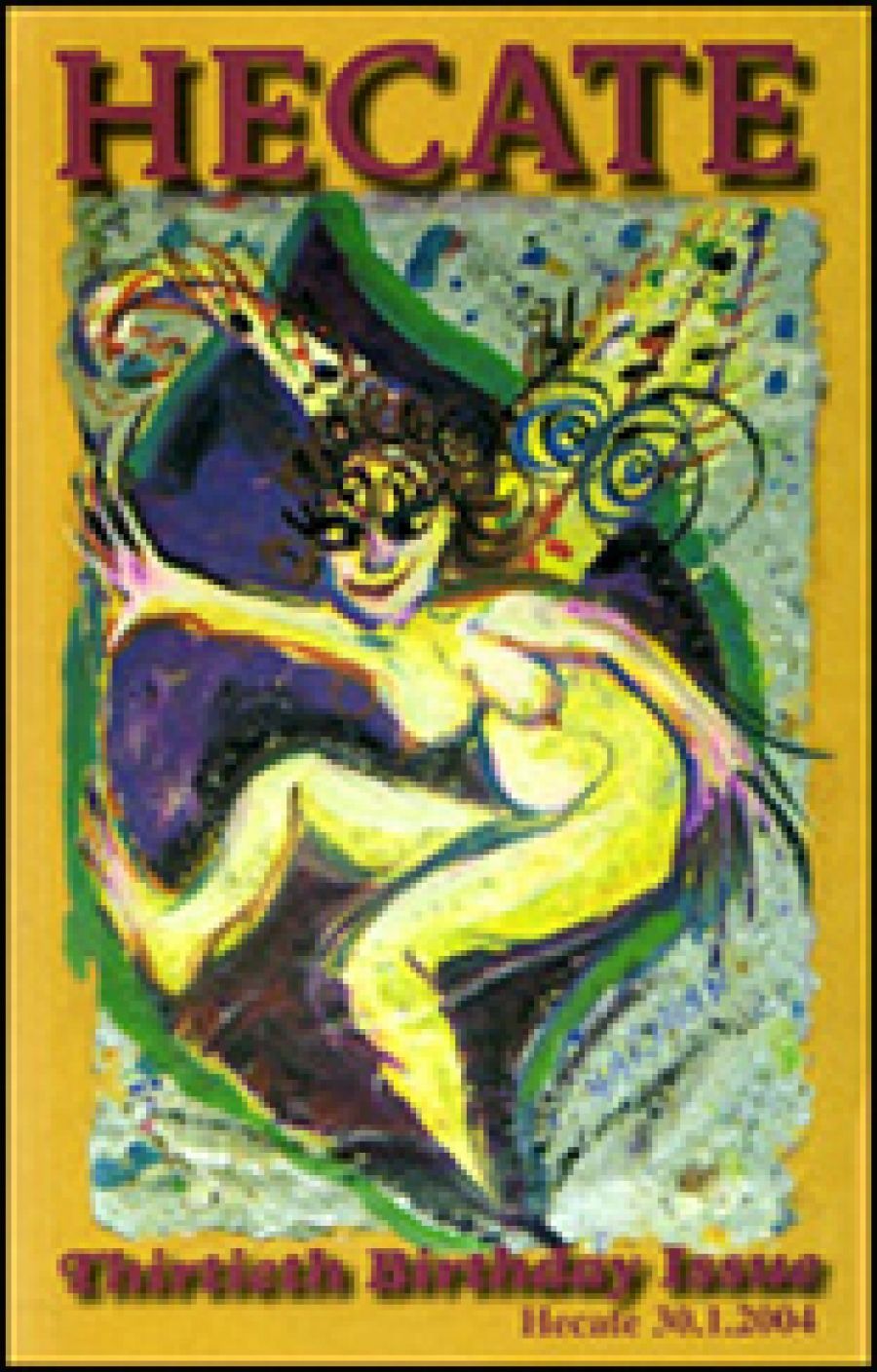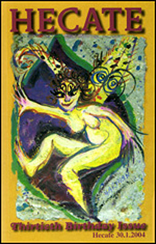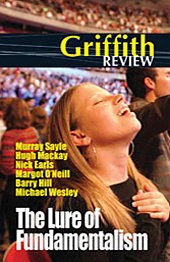
- Free Article: No
- Contents Category: Literary Studies
- Review Article: Yes
- Article Title: Just say no
- Online Only: No
- Custom Highlight Text:
Towards the end of the last century, Australian little magazines were forced to make a choice: become more interdisciplinary, or die. Those that have survived, and the new ones that have emerged, have taken on a new coherence and cohesion. Still mostly featuring a varied mix of writers, genres and approaches, they tend these days to have some unifying topic, or topos, and to be conducting a kind of internal conversation within their covers.
- Book 1 Title: Hecate vol. 30, no. 2
- Book 1 Biblio: $15pb, 212pp, 0311 4198
- Book 1 Cover Small (400 x 600):

- Book 1 Cover (800 x 1200):

- Book 2 Title: Island 99
- Book 2 Biblio: $11.95pb, 128pp, 1035 3127
- Book 3 Title: Griffith Review 7
- Book 3 Subtitle: The lure of fundamentalism
- Book 3 Biblio: ABC Books, $16.95pb, 268pp, 0 7333 1548 8
- Book 3 Cover Small (400 x 600):

- Book 3 Cover (800 x 1200):

Hecate, a tough survivor in this market, is still covering the ground it has always claimed: Australian feminism, women’s studies and women’s writing. This issue also has a stronger-than-usual focus on Queensland, which makes it an interesting comparison with the current Island, whose focus on issues Tasmanian is also particularly strong. Griffith REVIEW (as per their own typography, surely prone to constant misrepresentation) is a relative newcomer in the field and, unlike the other two, has no long history out of which it need evolve; from its inception it has focused each issue on a particular topical theme, approached from many points of view and explored across a range of genres and artforms.
This issue of Hecate features a special ‘Focus’ section on the struggle for women’s suffrage in Australia in general, and Queensland in particular; Carole Ferrier’s introduction gives a cogent overview bringing the topic up to the present day when the political clout of Australian women is still nowhere near what many of us would wish it to be, concluding that ‘old ideologies are newly materialising in relation to politics, practices and attitudes … that are not necessarily in the interests of many, let alone all, women’.
Elke Zobl’s article ‘Persephone Is Pissed! Grrrl Zine Reading, Making and Distributing Across the Globe’ takes itself extremely seriously and delights in its specialist language, amounting almost to a dialect, but it’s still required reading for anyone who wants to know about e-zine culture, third-wave feminism or the empowering mechanics by which zines provide direct channels of communication that bypass traditional cultural gatekeepers. If you’ve been wondering what a distro, a zinester or a Ladyfest is, this article is your chance to find out.
The other intriguing (and much more accessible) article of note is a study by Maryanne Dever of the collaborative friendship between Marjorie Barnard and Flora Eldershaw, looking at biographical and textual evidence to re-examine both the collaboration and the friendship. And any account of this issue would be incomplete without a mention of its gorgeous cover design, incorporating a sumptuous, intricate and beautiful bit of quilting by Eileen Haley.
Island 99 features a lot of unexpectedly haunting black-and-white images, including Ricky Maynard’s photograph Hands of a Muttonbirder, whose every detail draws you in and makes you wonder. This photograph is one of a series illustrating Andrys Onsman’s article ‘Shooting the Song of the Moonbirds’, which uses Maynard’s photography in its examination of the nexus of place, cultural practice, native wildlife and the significance of a totemic creature to the Bass Strait Islands Aboriginal community. The riveting thing about this article is the fact that Onsman goes out of his way to valorise but not sentimentalise mutton-birding as a traditional practice. It’s dirty, brutal and smelly; his description of it is deliberately stomach-turning, and anyone who wants to continue feeling warm and fuzzy about both cute baby animals and traditional Aboriginal practices is advised not to read this article.
Among the other Tasmania-specific pieces, there is an account of the CD Mining the Imagination: Queenstown: Spirit of the Place, which is a montage history in words and images of the mining community of Queenstown: ‘deep shafts, buggered hills, tough-as-old-boots miners, belting rain and Wild West mentality.’ There is a lyrical essay by Peter Grant on the geological formation of Tasmania, and another by Emily Stoddart about fires on Mount Wellington. Among the fiction and poetry, what stands out is Margaret Merrilees’s story ‘The Red Shoes’, a whimsical if slightly over-schematic (and over-paragraphed) hybrid narrative about the fairy-tale shoes and the Petrov Affair, and a poem called ‘Language of Swans’ by one Carolyn Fisher, of whose work I hope and expect to see more in the future.
I‘ve saved the best for last. Griffith REVIEW 7 is a demanding, disturbing and superb collection of writing, by some of the best and most subtle thinkers and writers in the country, on the terrifying topic of fundamentalism. The range of writing and images is broad, covering religious and political fundamentalism in a variety of manifestations and countries, and from multiple points of view: a clever, angry young Australian Moslem woman; an Australian writer newly coming out of retreat from his Northern Irish childhood; a sardonic blow-in resident of Tulsa, ‘self-proclaimed buckle of the Bible Belt’.
While none of the contributions address each other directly, there is a strong sense in this issue of conversational cross-currents chopping back and forth across its pages. Sociology professor John Carroll and seasoned ABC journalist Tom Morton arrive from radically different angles at the same conclusion: that contemporary Islamic fundamentalism is a direct product of Western modernity. Gideon Haigh’s essay on Russia and Stalin sends out little feelers of connection to Glyn Davis’s observations about Franco and Spain. Randa Abdel-Fattah is appalled by the mob mentality that reacts with hostility to her wearing the hijab in the streets of Melbourne, while, at the University of Sydney, student Eliza Blue is equally appalled by the mob mentality informing the student members of the Evangelical Union as they turn up in large numbers to hear a lecture, all wearing black T-shirts with ‘Absolute God’ written across the front.
While it’s hard to pick out highlights, the lead article is a substantial and profoundly knowledgeable, insightful and informative piece on the Holy Land – ‘painful to look at, impossible to look away’ – by international journalist Murray Sayle, and is probably the right place to start in any discussion of fundamentalism, its roots and its fruits:
What is the curse on that small corner of the world, where three closely related faiths endlessly invoke peace? Was there a fork in the road, and if so, where was it and when? The stakes go far beyond the Middle East – threatening us all with militant fundamentalism, an end to the toleration that has long kept religion and reason away from each other’s throats and has thus preserved our fragile civilisation.
There is also Barry Hill’s ‘Poems That Kill’, an essay spinning off Michael Leunig’s savage cartoon ‘Child Porn’. Hill’s article and its embedded poem sequence are partly autobiographical, drawing in observations from literature and philosophy: a self-portrait of a mind trying to come to terms with the words and images coming at us relentlessly and without respite down the wires of the world. When the first of the Iraqi dead were described as having been liquidated into a ‘pink mist’, what was the mind supposed to do with that phrase? Hill compares, in his speculations about the nature of evil, the grins on the faces of Bali bomber Amrozi and Abu Ghraib’s accused Private Lynndie England, in the best-known images of each. He invokes the words of Auden – ‘poetry makes nothing happen’ – and is brave enough to offer a kind of manifesto about poetry in these times, about what it might do and be: ‘poems as cats’-cradles, suspended between the head and the heart – delicate, strong constructions that are open to inspection.’
The last word, though, should go to Stuart Sim, author of Fundamentalist World (2004), quoted by Schultz in her introductory essay: ‘… fundamentalism needs to be unmasked – it’s about power, power over others. Just say no to fundamentalism … and keep saying it.’


Comments powered by CComment